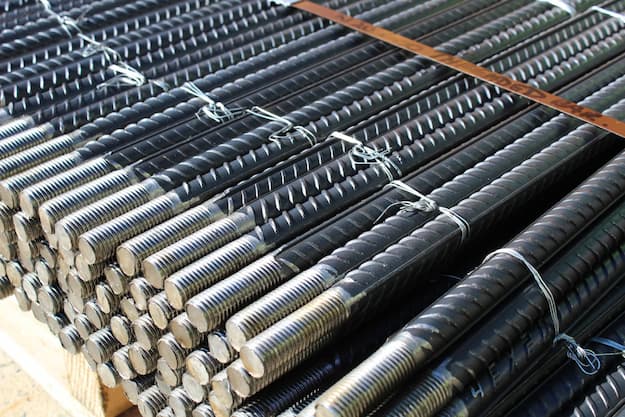Concrete is the most abundant construction material, second only to water. It is used in foundations, columns, beams, walls, and slabs and is chosen for its durability, strength, quick hardening, versatility and low cost. The material is waterproof, resists temperature extremes, and requires minimal maintenance once installed. The only drawback is that it needs to be reinforced.
While compressive stress is the material’s main strength, concrete performs poorly when subjected to tensile stress, or the forces trying to pull it apart. For this reason, reinforcing bars, or rebar made of ridged steel, are used. They enhance tensile strength, preventing the material from deforming, bending, cracking or breaking under load. Rebar strengthens concrete up to 10 times, meshing with it to form a composite material, allowing it to be malleable and flexible and maintain structural integrity even under very high loads.
One form of rebar, starter bar concrete, is used when connecting new to existing concrete, such as walls or columns to foundations. This has the same reinforcing benefits, ensuring a strong connection between the sections, and anchoring other elements such as walls and columns to existing foundations and slabs. By doing so, the entire structure becomes durable and stable.
Types of Starter Bars
Starter bars are single lengths of rebar, placed at defined intervals in footings, foundations or walls to ensure reinforcement overlap in adjoining structural elements. Different types are available to meet specific construction uses and needs. Bars differ in diameter, length and shape, and can be manufactured to meet specific project needs.
For safety purposes, these construction equipment pieces can be L-shaped, straight, or have hooks at the end before connecting components to the current structure. They can be installed in pillars or rectangular or circular footings (with the hooks facing outward). Because of the various kinds, joining wall pieces and other structural components is a relatively easy procedure. Although bars can be used separately, stirrups that join many bars in a mesh configuration guarantee greater tensile and compressive strength in the linked components.
Where loads increase, and reinforcement, embedding and anchoring requirements are more pronounced, builders use starter bars in layouts and systems designed to maximise strength and stability. Bars can be fixed in place with chemical anchors and resin for high holding strength, Not incidentally, new epoxy-based resins, now offer extreme load reinforcement, both in vertical and horizontal elements, with the highest strength, opening possibilities in terms of varied designs.
Along with chemical anchoring, starter bar concrete can be of the screw type. Bars embedded in the concrete slab or foundation can have an accessible female screw fixing sticking out. This is coupled with a continuation bar with male fixings, essentially thickening and strengthening the connection. The connecting possibilities do end there though. Similar systems are created using special metal formers anchored in the foundation. These connect to continuation bars by simply clicking or twisting into place, after which the concrete can be poured.
Other Reinforcing Elements Used With Starter Bars
While starter bars are often used on their own, other reinforcing elements like rebar, are often used in conjunction. Stirrups are looped rebar pieces, often used in bars in columns to increase lateral strength and prevent shear forces. Similarly, links made of plain steel bars can be added to further increase lateral strength in vertical connections. These have integrated end hooks to easily grip starter pieces, and together with stirrups help in correct alignment before pouring. Lastly, builders use corner bars for more strength in elements connected to corners in slabs. When sourcing these pieces, ensure they comply with project requirements such as strength and size.
Advantages These Construction Elements Provide
While there are several types of reinforcing methods, the use of starter bars offers several benefits:
- Increased lateral and tensile strength in the connected concrete parts.
- Structural integrity for walls, slabs, and connected columns.
- Bars in varying lengths (averaging 600mm for most uses, but easily cut to size), and diameters ranging from 12 to 20mm for metric variants. This opens up a range of connecting and reinforcing possibilities.
- Threaded bars are available for complex reinforcing systems, such as those mentioned above.
- Post-installation of chemically anchored starter bars in columns when affixing retaining walls.
Common Uses
Straight and L-shaped bars are used for most reinforcement purposes when adding new concrete elements. Typical instances are bars used to connect walls to footings or slabs, starter bars internally anchored into columns for additional strength, and when connecting retaining walls to hold back soil. To ensure structural stability and prevent bars from corroding, proper installation is key.
Common mistakes and misunderstandings happen when not using bars of the proper size and steel grade, not cleaning existing concrete, not using bonding agents, misaligning or incorrectly spacing bars, and not placing starter bars at the correct depth. The bar should also be protected from damage, such as exposure to soil or water, to prevent rust buildup.
Rebar Used for Starter Bars
The rebar used in starter bars for concrete is ribbed or deformed steel. The material can be hot-formed to achieve specific tensile strength requirements, as well as impressive heat and corrosion resistance. Resistance to rusting can be increased with hot-dip galvanised steel. Moreover, for better performance against shear and tensile stress in columns, bars can be combined with grout. The composite material adds strength, while also reducing corrosion. Other steel grades are also becoming common. For instance, high-strength deformed bars, or HSD, are used in areas requiring superior bonding strength with the concrete, and higher compressive and tensile resistance.
Safety Measures When Using Starter Bar
Starter bars are placed in foundations and footing, with protruding ends. This can be a safety risk, until pouring concrete for the connected section. Additionally, bars that are installed vertically or in smaller diameters can be harder to spot, and present risks for tool and machine operators. To remove potential hazards (tripping, cuts, issues with corded tools etc), bar ends should be marked with coloured caps. Hooked bars are a safer alternative to those with straight ends, while not costing much more.


